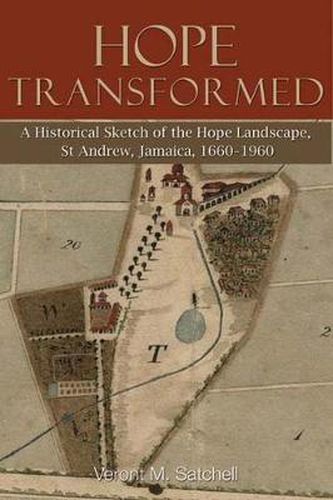Readings Newsletter
Become a Readings Member to make your shopping experience even easier.
Sign in or sign up for free!
You’re not far away from qualifying for FREE standard shipping within Australia
You’ve qualified for FREE standard shipping within Australia
The cart is loading…






The historic Hope lands located on the Liguanea Plain in the southeastern parish of St Andrew, Jamaica, and once the site of one of the island’s earliest sugar estates, has had a long history of human settlements dating back to approximately 600 CE, the era of the indigenous Tainos. It was not until 1655, however, with the English invasion and seizure of Jamaica from the Spanish, that the Hope landscape developed into a thriving rural agrarian settlement. Generous land grants were made to the invading officers and later to immigrants from Britain and North America and from other Caribbean islands. Major Richard Hope came in possession of over 2,600 acres in the Liguanea Plain. Major Hope, unlike many of his counterparts by the 1660s, managed to establish a small sugar plantation, which developed by the mid-1700s into one of the island’s largest, most productive and technologically advanced slave sugar estates. In the 1770s the estate became the property of the Duke of Chandos and his family until 1848, when the estate was dismantled. Over 600 acres were sold to the Kingston and Liguanea Water Works Company and the remaining 1,700 acres were leased to the owner of the adjoining Papine and Mona estates. Poor accounting and border surveillance enabled several persons to possess the land, which was later sanctioned by the Limitations of Actions Law. With the government’s acquisition of the entire property in 1909, the Hope estate underwent remarkable changes in the twentieth century. By 1960 the Hope landscape was radically transformed from a sugar estate worked by hundreds of enslaved black people to a premiere urban centre of commercial, residential and educational land use.
$9.00 standard shipping within Australia
FREE standard shipping within Australia for orders over $100.00
Express & International shipping calculated at checkout
The historic Hope lands located on the Liguanea Plain in the southeastern parish of St Andrew, Jamaica, and once the site of one of the island’s earliest sugar estates, has had a long history of human settlements dating back to approximately 600 CE, the era of the indigenous Tainos. It was not until 1655, however, with the English invasion and seizure of Jamaica from the Spanish, that the Hope landscape developed into a thriving rural agrarian settlement. Generous land grants were made to the invading officers and later to immigrants from Britain and North America and from other Caribbean islands. Major Richard Hope came in possession of over 2,600 acres in the Liguanea Plain. Major Hope, unlike many of his counterparts by the 1660s, managed to establish a small sugar plantation, which developed by the mid-1700s into one of the island’s largest, most productive and technologically advanced slave sugar estates. In the 1770s the estate became the property of the Duke of Chandos and his family until 1848, when the estate was dismantled. Over 600 acres were sold to the Kingston and Liguanea Water Works Company and the remaining 1,700 acres were leased to the owner of the adjoining Papine and Mona estates. Poor accounting and border surveillance enabled several persons to possess the land, which was later sanctioned by the Limitations of Actions Law. With the government’s acquisition of the entire property in 1909, the Hope estate underwent remarkable changes in the twentieth century. By 1960 the Hope landscape was radically transformed from a sugar estate worked by hundreds of enslaved black people to a premiere urban centre of commercial, residential and educational land use.